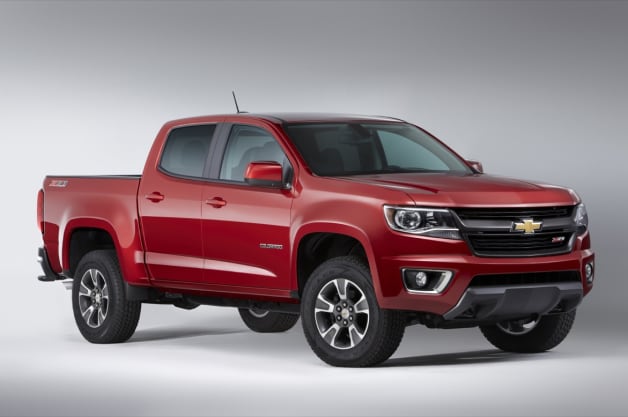
By Chris Bruce, Autoblog.com - Before even officially going on sale to customers, the GMC Canyon and Chevrolet Colorado midsize pickup twins are already proving to be a success with dealer orders exceeding original projections. Now, there is even more good news for these siblings, with the fuel economy for their four-cylinder engines netting class-leading numbers and the 3.6-litre V6 getting segment-best payload ratings.
The 2.5-litre four-cylinder in the two trucks makes 200 horsepower and 191 pound-feet of torque, and in rear-wheel drive and six-speed manual trim it has a fuel usage rating of 12.4L/100 km (19 mpg) city, 9L/100 km (26 mpg) highway and 10.7L/100 km (22 mpg) combined. Opting for a two-wheel drive configuration with the six-speed automatic bumps those figures slightly to 11.8L/100 km (20 mpg) city, 8.7L/100 km (27 mpg) highway and 10.7L/100 km (22 mpg) combined. Finally, a four-wheel drive model with the automatic 'box carries a 12.4/9.4/11.2 (19/25/21) rating. Those numbers are a tick better here and there compared to what's offered by the optional V6.
The twins' major four-cylinder, midsize pickup rivals are the Toyota Tacoma and Nissan Frontier, but they're both getting somewhat long in the tooth. To compare fuel economy and power, a two-wheel drive Tacoma with its 2.7-litre four-cylinder is rated at 159 hp and 180 lb-ft, and achieves 11.2/9.4/10.6L/100 km (21/25/22 mpg). The Frontier with its 2.5-litre four-cylinder is good for 152 hp and 171 lb-ft, and carries 12.3/10.2/11.2L/100 km (19/23/21 mpg) figures.
The V6 payload ratings are also class leading, with the Colorado rated at 712 kilograms (1,590 pounds) and the Canyon at 734 kilograms (1,620 pounds). According to parent General Motors, the 13.6-kilogram (30-pound) deviation is due to different curb weights for the models.
The Colorado and Canyon are already on their way to dealers.
The 2.5-litre four-cylinder in the two trucks makes 200 horsepower and 191 pound-feet of torque, and in rear-wheel drive and six-speed manual trim it has a fuel usage rating of 12.4L/100 km (19 mpg) city, 9L/100 km (26 mpg) highway and 10.7L/100 km (22 mpg) combined. Opting for a two-wheel drive configuration with the six-speed automatic bumps those figures slightly to 11.8L/100 km (20 mpg) city, 8.7L/100 km (27 mpg) highway and 10.7L/100 km (22 mpg) combined. Finally, a four-wheel drive model with the automatic 'box carries a 12.4/9.4/11.2 (19/25/21) rating. Those numbers are a tick better here and there compared to what's offered by the optional V6.
The twins' major four-cylinder, midsize pickup rivals are the Toyota Tacoma and Nissan Frontier, but they're both getting somewhat long in the tooth. To compare fuel economy and power, a two-wheel drive Tacoma with its 2.7-litre four-cylinder is rated at 159 hp and 180 lb-ft, and achieves 11.2/9.4/10.6L/100 km (21/25/22 mpg). The Frontier with its 2.5-litre four-cylinder is good for 152 hp and 171 lb-ft, and carries 12.3/10.2/11.2L/100 km (19/23/21 mpg) figures.
The V6 payload ratings are also class leading, with the Colorado rated at 712 kilograms (1,590 pounds) and the Canyon at 734 kilograms (1,620 pounds). According to parent General Motors, the 13.6-kilogram (30-pound) deviation is due to different curb weights for the models.
The Colorado and Canyon are already on their way to dealers.







